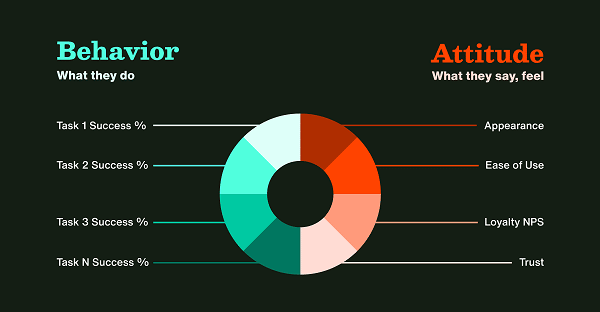It’s not always necessary to conduct user studies to determine if the product is performing well. We can learn a lot from complex data that shows how our work is progressing. User experience metrics are, therefore, numerical values used to illustrate the user experience.
What are UX metrics?
UX metrics allow us to draw solid conclusions and make UX design decisions based on factual, objective evidence, not opinions. They are crucial for user experience professionals:
- UX research helps:
- Increase on-page conversions
- Lower the rejection rate
- Improve site navigation
- Reduce the time it takes to complete a user’s goal
- Eliminate usability problems
- Find errors on the site
- Discover typical user behavior that you didn’t know about
- Find out how your product/service is perceived
- Evaluate the “look & feel” of the site in the eyes of your audience
Why should we measure UX?

Subjective feedback is not a good indicator for assessing the health of a site. Why? We have two main reasons. The first is the reliability of such information. By using UX metrics, you can monitor user behavior in real time. They are a great support for standard UX surveys. They show the actual state of affairs and outline the real situation.
Complex data, which can be measured and presented in graphs, better illustrate the tangible benefits of implementing changes in site design, are more convincing, and have more clout than subjective opinions. Measuring metrics has many benefits. It allows you to improve your website’s health, check the actual user experience and help you design a better experience for consumers using the site. It will enable you to achieve maximum results regarding website usability. In short, it supports user experience activities.
Types of methods for user experience metrics

Below you will find 6 methods for obtaining metrics in User Experience:
1. In-Depth Interview (IDI)
IDI stands for Individual-in-Depth Interview. An interview with a person from the target group was conducted according to a pre-designed scenario. Such an interview usually lasts a minimum of one hour.
To conduct an in-depth interview, you need a set of questions, preferably open-ended, to which you want answers. What is important here is the ability to delve into the threads raised by the respondent and ask in detail, allowing you to get to the heart of the matter and learn about deep needs and motivations.
2. Focus groups
A study conducted by a moderator stimulates discussion among participants so that different points of view, often completely opposite, are explored. The conversation should be guided by a pre-prepared scenario to bring up relevant themes and questions to which the company seeks answers.
Focus groups are useful for confronting the opinions of different groups of participants and for creatively generating new ideas and solutions. They do not necessarily have to relate only to the site’s usability. They can be broader and link to the company’s offerings, products, or communications, which can then be indirectly translated into changes in the interface or marketing communications.
3. Usability testing
Otherwise known as usability testing or user testing. Such UX testing involves developing many tasks based on popular behavioral patterns on the site, such as buying a product in an online store or finding information about a particular service on a company website.
The participant in the task then performs it under the guidance of an instructor, commenting on their actions and scoring errors on the site. Usually, this test is conducted among 5-10 people.
Usability tests can be conducted:
- In an automated manner
- Live, being in the same room with the participant
- Remotely connecting with the participant via video conference and observing his shared screen
4. Card sorting
This study involves assigning individual items to groups. It is useful in planning the site’s information architecture and menu navigation.
There are variations of the card sorting method:
- Closed card sorting – categories are predefined, and participants assign specific items to them.
- Open card sorting – participants are given items, which they group independently while coming up with their names for the created groups. A valuable method for getting to know the language that people in the target group naturally use in the context of a particular service.
- Free list – this method works well at the beginning of creating a new service. Participants independently create the groups and their names and the items themselves.
5. Prototyping
One of the simplest and trivial solutions. If you are planning changes to the site, you can first create a prototype on paper or in an app like UXPin or Figma, then show a few people and get their feedback. This is a quick and easy way to get feedback.
This way, you can also build simple navigation or element interactions and see if such an interface will be intuitive for users.
6. A/B tests
They are used to see if changes to a digital product positively affect user perception. The beauty of this technique is that you can test two different versions (options A and B) in real time and later see which one performs better.
Several tools are beneficial for this type of testing, including Marketizator, Optimizely, and Abtesting.net. Since a sufficient number of interactions with the interface in both versions should be collected here, these tests belong to quantitative research.
Undoubtedly the best way to improve the user experience on your website or software is to have a professional design team work on your project. Should you need assistance, you can always contact Limeup which has a huge variety of UX designers for hire.
Read also:



